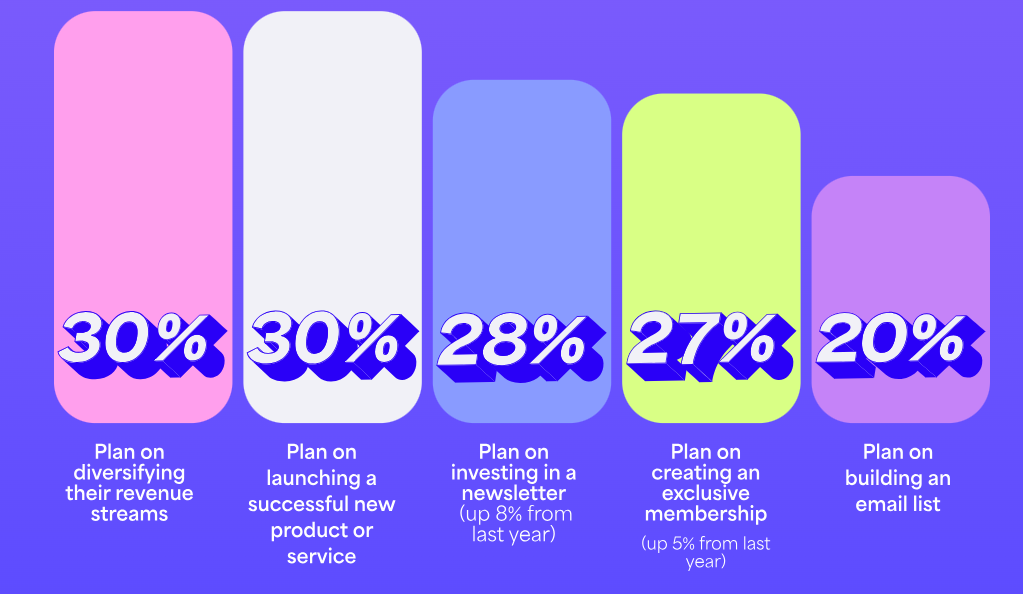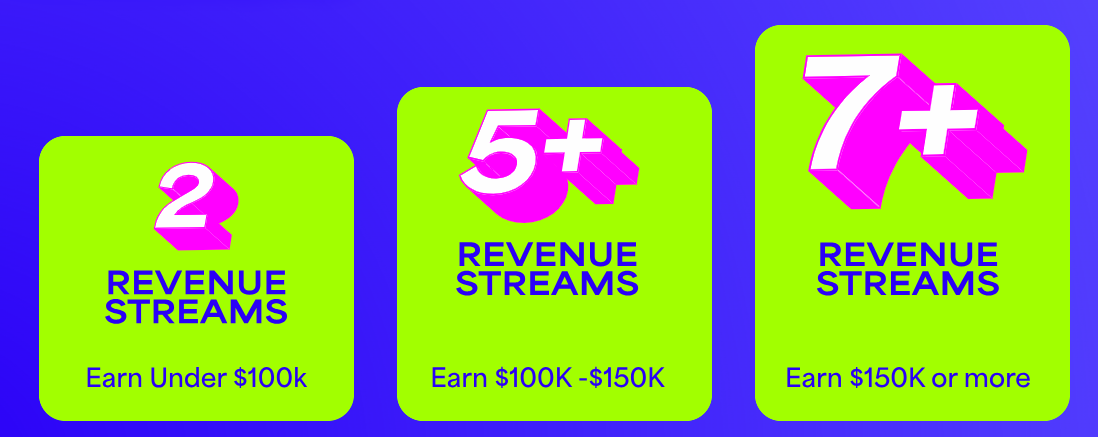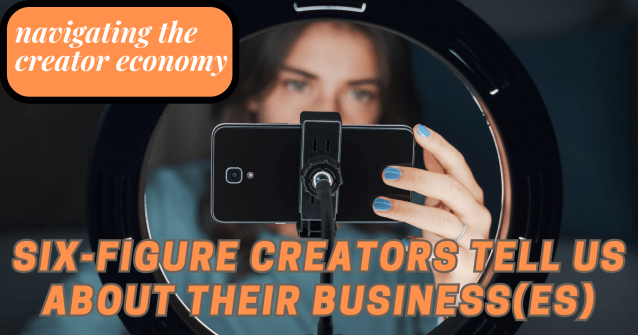
You've probably heard that the creator economy is predicted to become a $480 billion industry by 2027, but did you know that there will be over 50 million creators working in the industry in 2024? And 4% of these workers will earn over $100,000 annually. These figures are from Kajabi's “The State of Creators '24 Report.”

In this report, we focus on creators earning six figures or more, assess what they have in common, and explore what makes them successful in the creator economy.
How do creators (actually) make money?
First, being a successful creator takes more than social media posts and signing brand deals (though creators say these are important).
Creators say they need to diversify their income streams to break the six-figure ceiling, and having five (!) or more streams is a differentiator: And according to Kajabi research, creators making more than $150,000 a year use at least seven sources of income to earn their salary.

This is especially evident as 66% of creators say they derive the majority of their income exclusively from brand deals. However, these types of partnerships are unstable, and three-quarters of creators who identify as top earners say multiple income streams are essential to their financial success.[D]”Diversifying their revenue streams will empower creators to turn down deals that may undermine their authenticity,” the report said.
But it's worth noting that even authentic and successful creators say they're sometimes willing to compromise if the price is right: More than half of those making $100,000 or more said they would work with a brand that doesn't align with their values if the reward was right (without giving specific numbers).
So if you can't commit to a brand deal, what are some other popular options? Those at the club who earn six figures or more told Kajabi that they make their money from coaching and consulting work they do in-person or online, as well as passive income (digital products, platform payments, physical products, etc.).
Some of the most popular digital services include online courses, digital downloads, subscriptions or memberships, and online consulting/coaching.

Social is about engagement (and lead generation)
The creator economy may be synonymous with social media, but they're not the same. As Kajabi puts it: “Social platforms are great for growing your audience, not for business.”
Successful creators use lead generation strategies to convert followers into customers, leveraging their audience interaction and community to cash generated on the platforms they own.
But creators are unlikely to abandon social media anytime soon. Even creators making six figures would be hurt if they lost access to the platforms. Losing YouTube would mean losing at least $50,000 a year for 42% of creators making more than $100,000. Thirty-eight percent of those surveyed would suffer similar losses if Instagram went bust, 37% would suffer similar losses if TikTok went bust, and 36% said the same would be true for Facebook.

Despite these numbers, half of creators say they don't trust the social media platforms that made them popular — after all, they've suffered bad experiences in the past — and Kajabi said it will be interesting to see if TikTok's creativity programs change creators' attitudes.
Demographics of Six-Figure Creators
The most successful creators in 2024 are:
- Male (57%)
- 80% have a bachelor's degree or higher
- Working full-time as a creative (86%)
- Create content for niches like business, marketing, finance, real estate, etc.
They also tend to reach this economic tier relatively quickly: 4 in 10 people who earn six figures achieved that status within two years of starting work in the creator economy. Notably, the content categories that catapult creators into this range the quickest are beauty, fitness, and gaming.
Their thoughts on today's hot topics
Kajabi also asked about creators' attitudes toward two of 2023's hottest topics: AI and unionization.
AI emerged as a key differentiator for financially successful creators, who are twice as likely to use AI as those making less than $99,000 a year, with 29% saying they use AI tools daily and 43% saying they use them weekly.
According to Kajabi, “six-figure earners are looking to AI in 2024, specifically to save them time and ultimately reduce creator burnout.”
Moreover, even if they are successful, creators don't want to be independent: Perhaps due to distrust of social enterprises, about 50% of creators said they would like to join a creators' union if one were to be formed. Notably, their interest was higher than that of their lower-income peers.

Now, let's discuss!
Our partner, Virtual Events Group, will be hosting a webinar on March 14th at 3pm ET focusing on the creator economy and previewing the new Creator Lab at the NAB Show.
Sign up now for an instant preview of “A new generation of tools, content and distribution channels that are disrupting traditional media.”
The VEG group was designed to allow participants to[m]Come meet the creators, preview products, and see an industry being born.”


